Knitting can be a powerful tool to calm your anxiety through five key mechanisms. The rhythmic movement of needles induces a soothing state, while focusing on intricate patterns quiets racing thoughts. As you create tangible progress, you'll boost your self-esteem and counteract negative self-talk. Joining social knitting groups fosters connection and support, reducing feelings of isolation. Finally, the soft textures of yarn provide sensory comfort, grounding you in the present moment. By incorporating these therapeutic aspects into your knitting practice, you'll discover a potent strategy for managing anxiety and promoting overall well-being. Let's explore each of these calming techniques in more detail.
Rhythmic Movement Induces Calm
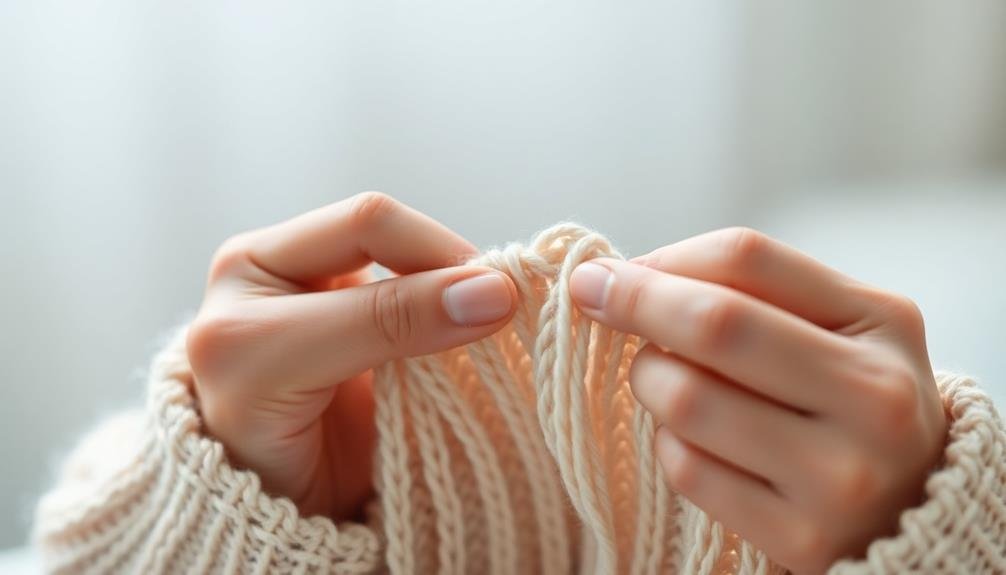
The repetitive motion of knitting needles creates a soothing rhythm that can calm your mind and body. As you engage in this rhythmic activity, your brain begins to release neurotransmitters like serotonin and dopamine, which are known to reduce stress and promote relaxation.
The consistent, back-and-forth movement of your hands as you knit helps to focus your attention on the present moment, drawing it away from anxious thoughts. This meditative-like state induced by knitting's rhythmic motion can lower your heart rate and blood pressure, further contributing to a sense of calm.
You'll find that the predictable pattern of stitches allows your mind to enter a flow state, where time seems to slow down and worries fade into the background. To maximize the calming effects of knitting's rhythmic movement, try to maintain a steady pace and focus on the sensation of the yarn moving through your fingers.
Pay attention to the sound of the needles clicking together and the feel of each completed stitch. By immersing yourself in these sensory experiences, you'll enhance the anxiety-reducing benefits of knitting's soothing rhythm.
Focusing on Patterns Quiets Thoughts
Intricate patterns in knitting serve as a powerful tool for quieting anxious thoughts. When you focus on following a complex knitting pattern, your mind becomes absorbed in the task at hand, leaving little room for worry or rumination. This mental engagement acts as a form of mindfulness, anchoring you to the present moment.
As you count stitches, track rows, and execute specific techniques, your brain shifts its attention away from anxious thoughts. The concentration required to interpret and follow knitting instructions engages your cognitive functions, effectively crowding out negative mental chatter. You'll find that the more intricate the pattern, the more it demands your focus, providing a welcome respite from anxiety.
Moreover, the visual and tactile elements of knitting patterns offer additional sensory input that can further quiet your mind. The act of creating something beautiful and orderly from a seemingly chaotic bundle of yarn can be deeply satisfying and calming.
Tangible Progress Boosts Self-Esteem
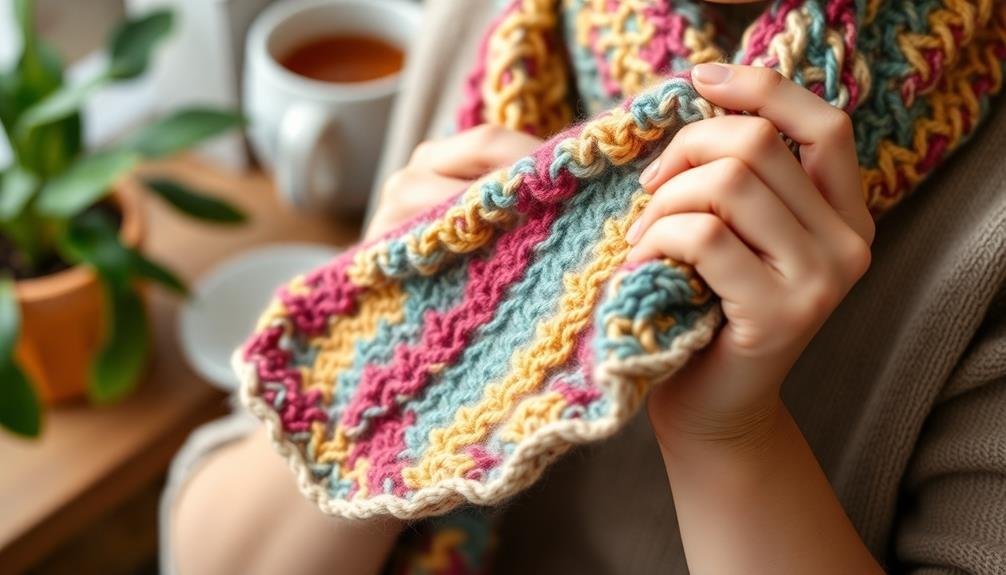
As you knit, row by row, you'll witness tangible progress that can greatly boost your self-esteem. Each stitch you complete is a small achievement, and as your project grows, so does your sense of accomplishment. This visible progress serves as a powerful reminder of your capabilities and can help counteract negative self-talk often associated with anxiety.
Tracking your knitting progress can further enhance this effect. Consider using a simple chart to document your journey:
| Day | Rows Completed | Feelings |
|---|---|---|
| 1 | 10 | Hopeful |
| 2 | 25 | Proud |
| 3 | 40 | Confident |
| 4 | 60 | Accomplished |
Social Knitting Groups Foster Connection
Knitting needles aren't just tools for crafting; they're conduits for connection. When you join a knitting group, you're entering a supportive community where shared passion fosters friendships. These gatherings provide a safe space to discuss your anxieties while focusing on a common activity, reducing feelings of isolation.
In social knitting groups, you'll find:
- A non-judgmental environment where everyone's at different skill levels
- Opportunities to learn new techniques from experienced knitters
- A chance to share your progress and receive encouragement
- A regular social commitment that gets you out of the house
- A diverse group of people with varied life experiences to learn from
As you knit alongside others, you'll naturally engage in conversation, sharing stories and laughter. This social interaction can greatly reduce anxiety symptoms by increasing feelings of belonging and purpose.
You'll also benefit from the collective creative energy, inspiring you to tackle new projects and push your boundaries.
Soft Textures Provide Sensory Comfort
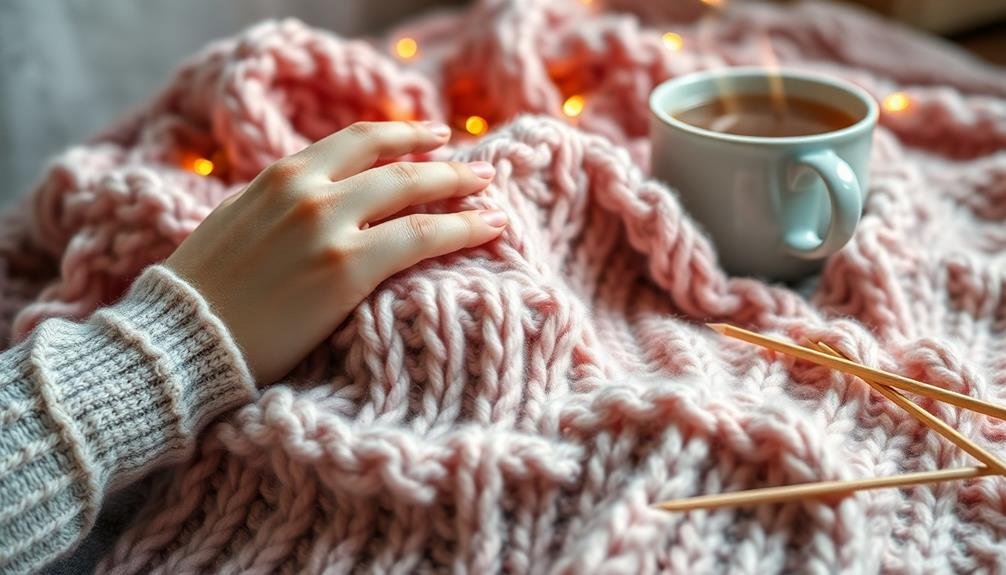
The tactile experience of working with soft yarn can be incredibly soothing for those struggling with anxiety. When you're feeling overwhelmed, focusing on the gentle texture of wool, cotton, or alpaca fibers can help ground you in the present moment. Choose yarns that feel comforting against your skin, and let your fingers explore their softness as you knit.
Different textures can evoke various emotional responses, so experiment with various fibers to find what works best for you. Here's a quick guide to help you choose:
| Fiber Type | Texture | Emotional Effect |
|---|---|---|
| Merino Wool | Soft, fluffy | Comforting, cozy |
| Cotton | Smooth, cool | Calming, invigorating |
| Alpaca | Silky, warm | Luxurious, indulgent |
As you work with these materials, pay attention to how they feel in your hands. The repetitive motion of knitting combined with the sensory input from the yarn can help quiet racing thoughts and reduce stress. You'll find that focusing on the texture and feel of the yarn becomes a form of mindfulness meditation, allowing you to step back from anxious thoughts and find a moment of peace in your craft.
Frequently Asked Questions
How Long Does It Take to Learn Knitting for Anxiety Relief?
You can learn basic knitting for anxiety relief in a few weeks. It's a personal journey, so don't rush. You'll likely feel some calming effects immediately, but mastering techniques may take several months of consistent practice.
Can Knitting Help With Other Mental Health Conditions Besides Anxiety?
Yes, knitting can help with various mental health conditions. You'll find it beneficial for depression, PTSD, and stress management. It can improve self-esteem, focus, and mindfulness. You might also experience better sleep and reduced chronic pain symptoms.
Are There Specific Knitting Patterns Recommended for Managing Anxiety?
You'll find simple, repetitive patterns like scarves, blankets, or dishcloths most soothing for anxiety. Try ribbing, garter stitch, or seed stitch. These don't require much concentration, allowing you to relax and focus on the rhythmic motions.
What Are the Best Yarns and Needles for Anxiety-Reducing Knitting Projects?
You'll find soft, smooth yarns like merino wool or bamboo most soothing. Choose larger needles for easier handling. Wooden or bamboo needles are warm and quiet. Stick to light colors that calm you. Don't forget circular needles for versatility.
How Often Should One Knit to Experience Anxiety-Relieving Benefits?
You'll benefit from knitting daily, even for short periods. Aim for 15-30 minutes to start, gradually increasing as you're comfortable. Consistency is key, so try to make it a regular part of your routine for ideal anxiety relief.
In Summary
You've discovered how knitting can be a powerful tool for managing anxiety. As you've learned, the rhythmic motions, focus on patterns, and sense of accomplishment all contribute to a calmer state of mind. Don't forget the social benefits and comforting textures too. Whether you're a beginner or an experienced knitter, you can harness these therapeutic effects. So pick up those needles and yarn—you're not just creating a project, you're crafting peace of mind.
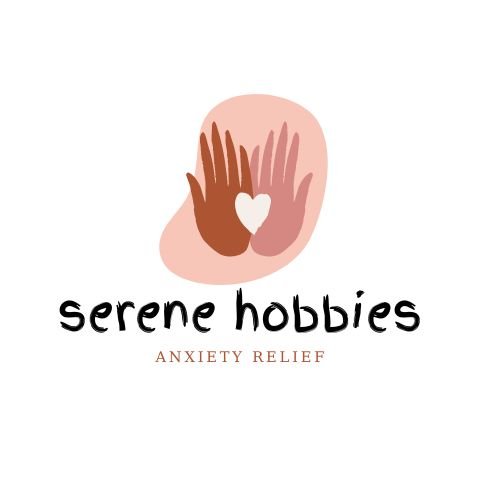
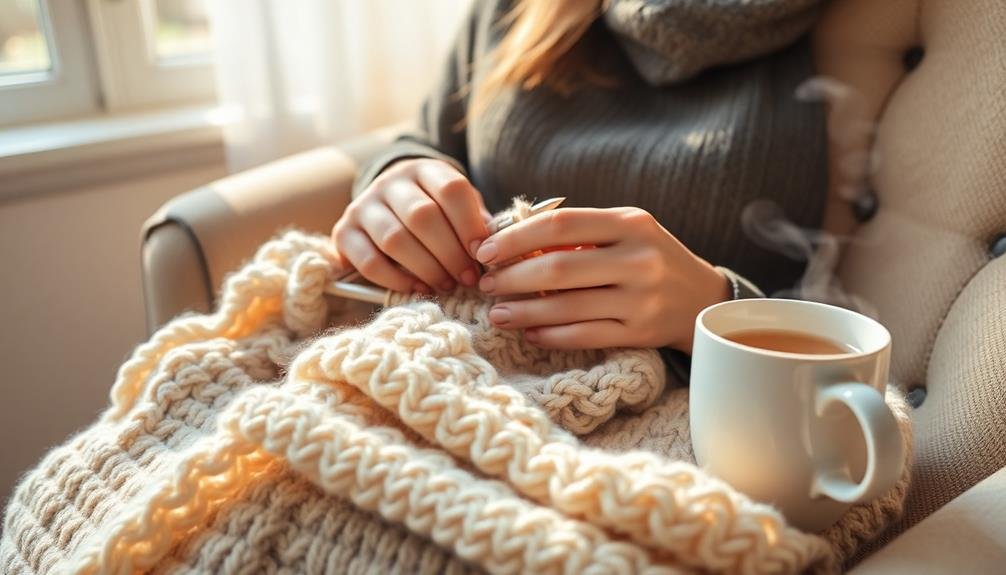
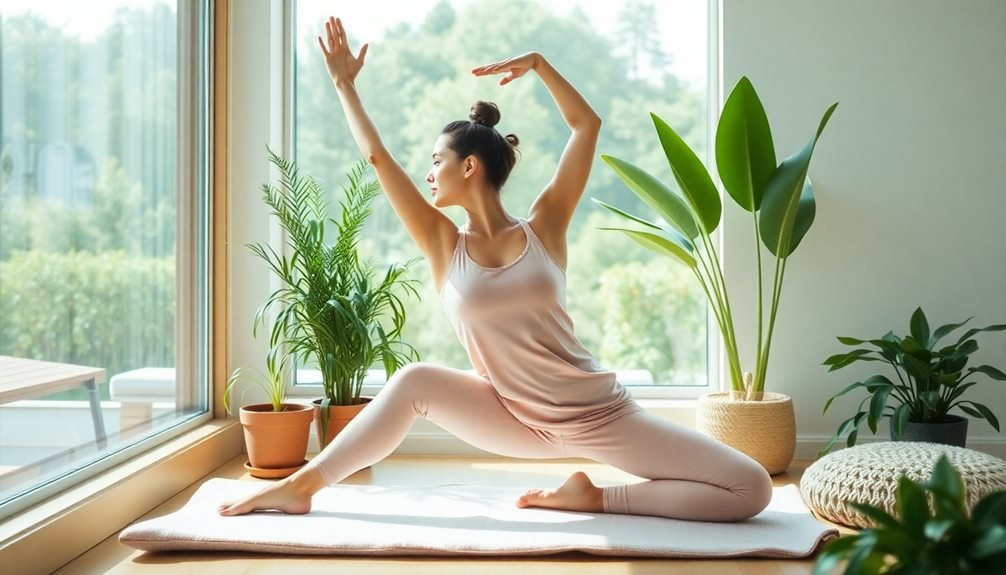


Leave a Reply